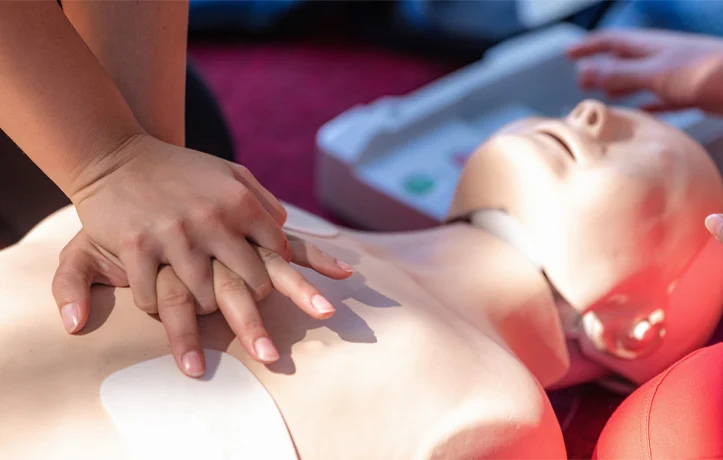STAY UPDATED WITH NASM!
CPR, or Cardiopulmonary Resuscitation, is a life-saving skill you hope you never have to use, but it could save someone’s life if you do. Each year, the first week of June is National CPR and AED Awareness Week – a week dedicated to educating the public on the importance of learning CPR and how to use an AED to save the life of a loved one, should they need emergency care.
HOW WAS NATIONAL CPR AND AED AWARENESS WEEK INITIATED?
The American Heart Association collaborated with the American Red Cross and the National Safety Council to establish National CPR and AED Awareness Week in 2007 with the goal of teaching more people how to do CPR and using an AED (automated external defibrillator) to save more lives. Since 70% of out-of-hospital cardiac arrests happen in homes, it’s likely that you’d be working to save the life of someone you know and love.
In the 1960s, doctors William Kouwenhoven, Peter Safar, and James Jude came up with the life-saving technique that we know today as CPR, but that’s not where it began. CPR dates back to the 1500s when physicians sought techniques to revive patients. Many methods were trial and error, with technique progressing as an understanding of the human body evolved over time.
CPR as we know it today progressed over time. The mouth-to-mouth technique was first used in 1732 by surgeon William Tossach to revive a coal-pit miner, and the technique was officially recommended in 1740 by the Academie des Sciences in Paris for drowning victims.
The first heart to be shocked back into a normal rhythm was that of a chicken in 1775, a discovery that eventually led to the use of external defibrillation on a human heart in 1956. In 1956, Dr. James Elam and Dr. Peter Safar prove that mouth-to-mouth resuscitation is an effective lifesaving method. In the 1990s, AEDs became available for public use, and in 2008 the AHA released the “hands-only” technique to encourage bystanders to jump in and help a fallen victim.
CPR BASICS FOR FITNESS PROFESSIONALS
Administering CPR immediately could double or triple a victim’s chance of survival. As a fitness professional, you’ll need to be up-to-date on your CPR/AED credentials to maintain your certification, but anyone can use the following steps to administer hands-only CPR to save a life.
1. Call 9-1-1. Do this as soon as you see anyone suddenly collapse and remain unconscious. You can have someone else call while you begin compressions. If you’re alone with the victim, dial first and put it on speaker letting the 9-1-1 operator know that you are beginning compressions.
2. Start compressions. Place the heel of your hand in the center of the victim’s chest with the other hand stacked right on top. Push hard and fast in the center of the chest to the beat of “Stayin’ Alive” by the Bee Gees, or any other song that has 100 to 120 beats per minute.
3. Keep going until the person wakes up, help arrives, or as long as you can. If another person is there with you, switch with them as soon as you become too tired to continue.
If an AED is available on the scene, you’ll want to get the victim hooked up immediately so it can scan their heart rate. The AED will give verbal step-by-step instructions for when to back away for a shock, and when to continue to administer CPR.
HOW CAN YOU OBSERVE NATIONAL CPR/AED WEEK?
- Get your CPR/AED certificate
- Share this 90-second hands-only CPR instructional video from AHA on your social media
- Look for an AED at work and in public spaces that you visit so that you know where they are in case of emergency
- Share what you learned on social media – it might just save a life!

